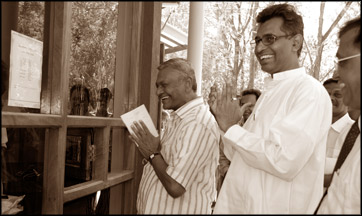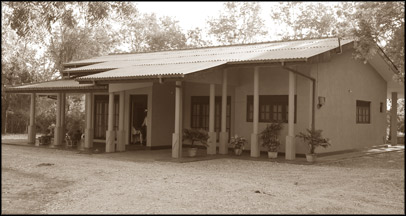|
'Development need not be synonymous with
eco-degradation':
Revamping national parks in a post-war setting
by Sajitha PREMATUNGE
A greater part of national protected areas have been inaccessible due
to the decade long war on terrorism. If favourable conditions for
animals are not maintained within these protected areas, the carrying
capacity - the number of animals the area can support - may it be
elephants, leopards or deer, is bound to go down.
 |
|
Lunugamvehera
information centre |
Consequently the Department of Wildlife Conservation has adopted
habitat enrichment practices, such as taking out invasive flora and
fauna from the natural environment, maintaining water holes and
controlled burning to make way for young grass as a food source for
grazers like elephants. All of which were totally abandoned due to
continuous terrorist attacks.
But now the tables have turned and the Ministry of Environment and
Natural Resources together with the Department of Wildlife Conservation
and the Department of Irrigation have taken the initiative to improve
Sri Lanka's National Parks and restore their lost prestige.
As the first step of this endeavour the Lunugamvehera National Park
is now open to the general public, with all new facilities, complete
with the Thalgahadigana circuit bungalow, an Information Centre - which
was opened last week by Irrigation and Water Management Minister Chamal
Rajapaksa and Environment and Natural Resources Minister Patali Champika
Ranawaka - two Divisional Offices and an elephant rehabilitation centre.
The Lunugamvehera National Park - a haven for wildlife - extends
23498 hectares within the Moneragala and Hambantota districts.
Lunugamvehera - although technically a National Park - has not been
considered as a Park due to lack of facilities. It had been considered
as a mere intermediate strip of ground connecting Udawalawa and Yala
that wildlife use to migrate between the two parks in times of food and
water shortages. However, Lunugamvehera National Park is a major
catchment area of Veheragala and many other smaller reservoirs.
Minister Champika Ranawaka said development need not always be
synonymous with environment degradation. Wildlife can thrive side by
side with social and economic development. "This is most evident
considering the feat achieved by the Veheragala and Mawu Ara Irrigation
Project engineers", said the minister. For the first time in Sri Lanka
local engineers have been responsible for the construction of two
reservoirs and have been able to complete the projects for half the cost
that would have been spent on foreign technology. The renovated
Veheragala-Lunugamvehera irrigation system has eased the water problem
in the Lunugamvehera elephant rehabilitation and holding ground. With
the Veheragala Project some of the former glory of the Udawalawa and
Lunugamvehera National Parks has been restored.
Minister Champika Ranawaka further explained that smaller reservoirs
and water bodies facilitate vegetation growth that is an ideal source of
food for grazers like elephants. The Ministry of Environment and Natural
Resources hopes that the abundance of food would prevent elephants from
attacking villages.
 |
|
A view of the
Lunugamvehera divisional office |
Director General, Department of Wildlife Conservation (DWC), Ananda
Wijesooriya, said 100 million worth of building of the allocated Rs. 350
million have already been done. He claimed that the number of staff has
been increased and facilities, services and infrastructure improved for
the benefit of the visitors. The minister said with the end of war they
can now start focusing on improving the Yala National Park as well.
The Gonagala Reservoir has been renovated and the capacity of the
Butewa Wewa in Yala National Park has also been increased. The
restoration process of Ratmal Wewa has already begun. Most of the parks
grasslands have been restored by clearing the habitat of invasive flora
such as *Lantana* and cactus, making way for young grass. Two bowsers
provide water to ten water holes dug up in identified locations in the
Park. K. Janaka Shantha Kumara, a wildlife ranger claimed that as a
result a clear metamorphosis of a whole ecosystem can be observed. As
grazers increase due to the availability of food and water, the number
of predators like the leopard - one of the major tourist attractions in
Yala - has also increased in number.
A corridor connecting Yala Block II and III to Kumana and Block V to
Lunugamvehera is in the making. They are also hoping to connect Wilpattu
to this chain. Since Udawalawa is adjacent to Lunugamvehera the whole
network of National Parks will be interconnected making foraging easy
during food and water shortages.
Ananda Wijesooriya said, having to close down parks due to security
reasons, however necessary, resulted in a major loss of revenue to the
country. Yala and Horton Plains National Parks bring in the highest
income among Sri Lanka's protected areas. Between January and June 2008,
9078 locals and 7532 foreigners have visited the Yala National Park
bringing an income of Rs. 16.6 million. In 2009, between the same
period, the number of locals who visited Yala rose to 18,031 and
foreigners to 10,439. The revenue brought soared to Rs. 27 million in a
few months. The Minister appreciated the great sacrifice made by
security forces in the attempt to liberate the country.
During the foundation stone laying ceremony of the Dr. Ravi
Samarasinha Memorial Visitors Centre in Yala last week, Minister
Champika Ranawaka revealed that although the Asian Development Bank (ADB)
agreed to provide funds for the improvement of the park it could not be
utilized because the park had to be repeatedly closed down due to
terrorist attacks. "But with the war over, the allocated ADB funds can
finally be put to use." This they hope would get the parks up and
running before long. Minister Champika Ranawaka revealed that Wilpattu
and Kumana will be reopened as soon as the restoration process is
complete. Kumana will most probably reopen within two months.
The Director General, DWC revealed that they hope to build two
visitors' centres in the Southern Province, build 130 km of roads and
open more circuit bungalows. A World Bank funded project to improve
infrastructure for visitors is scheduled to commence next year.
"However, no amount of rebuilding is of use if one fails to fulfill
one's responsibilities", emphasized the Minister. He claimed that the
full responsibility and welfare of wildlife lay with the Ministry of
Environment and the DWC and that these institutions were their only hope
for survival. |

